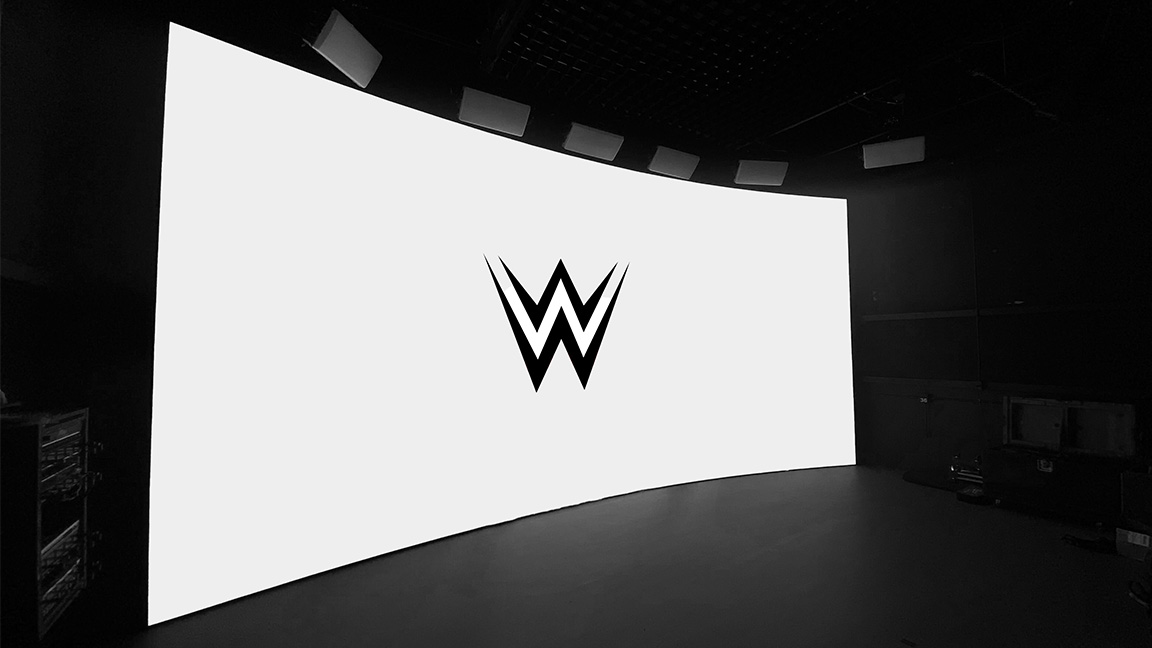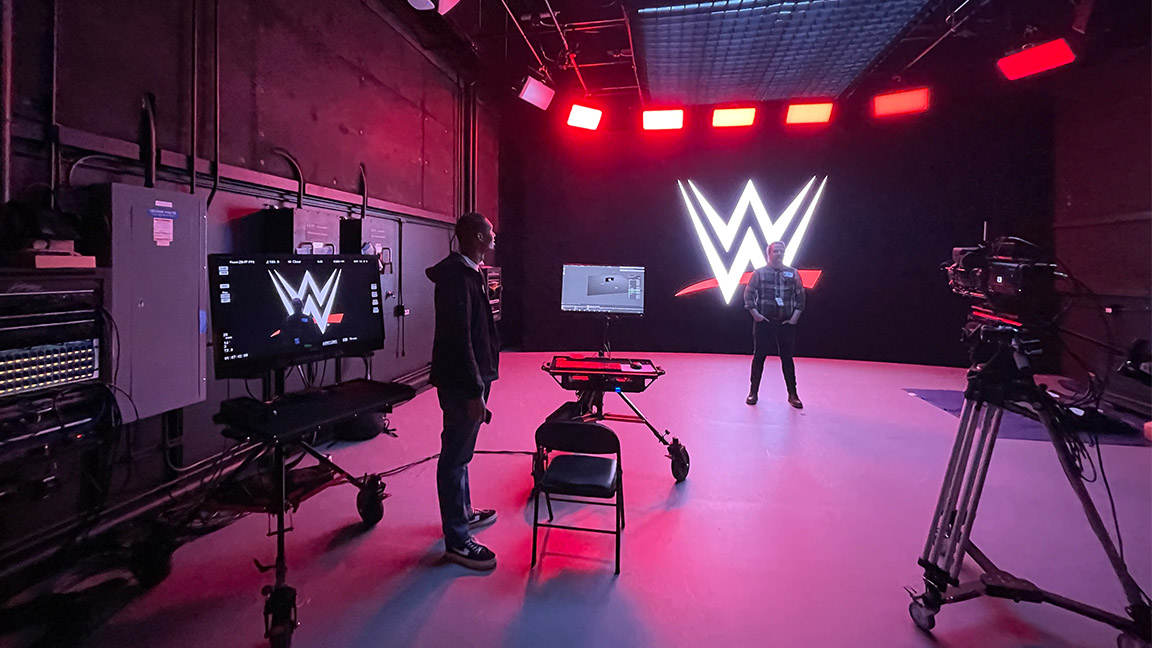From iconic body slams at the Pontiac Silverdome to whimsical tirades from The Rock, World Wrestling Entertainment has constantly reinvented itself to keep its millions of fans entertained. Recently, the WWE unveiled its new 30,040-square-foot production facility, The Studios at WWE, located at WWE headquarters in Stamford, CT. The five-studio venue has the production capabilities to further enhance the storylines of its beloved heels and heroes, including a new virtual production stage created in collaboration by AbelCine and Atlanta-based virtual production experts Meptik.
[The Integration Guide to Video Walls 2024]
Though The Studios at WWE were an ongoing project, Meptik joined on last fall to design the virtual production set in Studio 3. Brought on by its partners at AbelCine, the project seemed like a perfect fit.
“Many of us at Meptik are passionate WWE fans, which added an extra layer of excitement to the project,” said Nick Rivero, co-founder of Meptik. "The Studios at WWE boast a gigantic WWE championship belt at the entrance—a perfect photo opportunity that our team eagerly took advantage of after the project was wrapped. Plus, the lobby features an actual wrestling ring, placed right at its heart. The entire space is truly incredible."
For Rivero, one of the highlights of the project was the panel discussions at 2024 NAB Show last April, where the company joined forces with WWE, Sony, and AbelCine to unveil the project for the first time. "WWE generously provided two championship belts for photo opportunities throughout the event, which were a huge hit with the attendees," he recalled. "We’ve kept one of the belts at our office in Atlanta, and it’s been a constant source of excitement.”
Continued Commitment
Fanboying aside, the project has brought new possibilities to WWE storytelling. The project installation took some time to complete, but Meptik’s work is never done.
"Our work on Studio 3 spanned eight months from inception to completion," Rivero explained. "At Meptik, we view our role not just as builders of virtual production studios, but as true partners committed to the success of our client’s projects. That commitment doesn’t end with construction. We’re still actively involved with Studio 3, working closely with the WWE team to ensure they are fully equipped to use the virtual production stage effectively.
"Currently, we’re focusing on training sessions that cover everything from optimizing lighting setups to mastering the Disguise platform. Moving forward, we will continue to provide support for the WWE team, ensuring they have all the assistance they need for upcoming shoots and to utilize the studio to its full potential."

AbelCine equipped the WWE production team with the Sony VENICE 2 camera complemented by Fujinon Premista lenses. According to Rivero, the choice of VENICE 2 cameras came down to image quality and flexibility in dynamic lighting conditions found on a virtual set.
To showcase the storytelling on Studio 3, Meptik stayed with Sony technologies for the LED stage. "Our decision to utilize Sony’s Crystal LED VERONA panels was driven by their established relationship with WWE," said Rivero. "The WWE broadcast team had been using Sony technology for a long time, which made it a logical choice to continue with Sony for their virtual production studio."
Rivero said Studio 3 is the first in North America to utilize Sony’s new LED panels, which "perfectly matched what the WWE team needed." Ideal for in-camera VFX applications, the setup at WWE includes a main wall comprised of 128 Crystal LED VERONA cabinets, plus two mobile LED carts that can be repositioned as needed.
"It provides them with a flexible and high-quality solution that perfectly complements the dynamic nature of WWE’s production requirements," he noted. "This innovative technology was precisely the missing piece that completed the visual experience WWE aimed to achieve."
When it came to powering the content, it was a no brainer. The Disguise platform is one of the solutions that brings the Vegas Sphere's visuals to life. Meptik began its working relationship with Disguise long before the two became part of the same company. Now the creative and technical division for Disguise, Meptik took to Studio 3 to bring the WWE's creative visions to life.
"An important reason we went with Disguise is flexibility," Rivero said. "Their platform is highly adaptable and content-agnostic, which means the WWE team can throw pretty much any type of content from different software into the mix without a hitch. It just makes everything smoother when you’re trying to produce something great.”
Keeping It Unreal
With Sony and Disguise behind the virtual production, WWE can generate all its content right there. So, how does that content come to life?
"WWE has previously used Unreal Engine for their content creation, and they will continue to use this platform extensively," Rivero explained. "Their in-house content team is quite familiar with it, and it's well-suited for the dynamic and immersive experiences they aim to create. However, since the Disguise system we've implemented is content agnostic, WWE isn't limited to just Unreal Engine. They have the flexibility to incorporate other content creation software as well."

At NAB, Russ Kornstein, SVP of on-air promotions at WWE, said the company generates 5,000 pieces of content a month. "WWE is already well-known for its dynamic range of content production, from live broadcasts and major events to engaging social media posts," Rivero said. "I expect that the new content being produced in Studio 3 will naturally build on this strong foundation."
Without giving away too much of the future surprises for WWE fans, Rivero said the WWE already has a lot planned, and Meptik is providing support for future productions. On top of that, WWE designed the studios not only for its own content productions but also with the vision of opening their doors to external sports and media organizations. " Their needs are very broad. One day, they could shoot a live TV interview, then the next day have a wrestling show, and then they might shoot a commercial the day after that," he said.
Focused on the story arcs of its wrestlers as much as the action itself, the WWE content team is no stranger to detailed storytelling with innovative technologies. Meptik and AbelCine have now created an environment that is versatile and dynamic, much like the WWE heroes and antiheroes themselves. Whether it is an up close and personal look at a Stone Cold Stunner or a conversation with undisputed champion Cody Rhodes, the possibilities from Studio 3 are endless.
"With an LED stage, WWE’s team will now be able to quickly switch out locations so that they can capture people against any backdrop faster than ever before," Rivero added. "They can get their talent in there for branded IDs, and they can use the stage to really lean into the wrestling characters—so if a persona is from the backwoods, they can capture them in the middle of a swamp and make a mini-movie if they wanted to. A virtual production studio is the perfect solution for WWE’s team."

